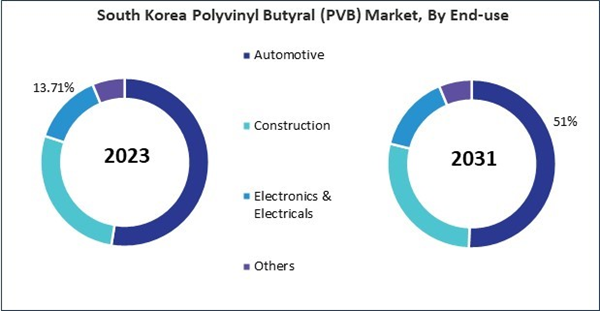Polyvinyl Butyral (PVB) serves a multitude of purposes in the adhesives industry, thanks to its unique properties and versatile applications. PVB adhesives are widely utilized in industries such as construction, automotive, and aerospace for bonding various substrates including glass, metals, and plastics. In the construction sector, PVB adhesives are favored for their strong adhesion properties, making them ideal for laminating glass panels in architectural structures. Thus, the China market consumed 5,623.46 tonnes of this chemical in adhesives applications in 2023.
The China market dominated the Asia Pacific Others Market by Country in 2023, and is forecast to continue being a dominant market till 2031; thereby, achieving a market value of $52.4 million by 2031. The Japan market is registering a CAGR of 6% during (2024 - 2031). Additionally, The India market would showcase a CAGR of 7.3% during (2024 - 2031).
PVB coatings impart water resistance to textiles and leather, preventing moisture penetration and reducing the risk of water damage. The coatings also provide stain resistance, making cleaning and maintaining the materials easier by preventing liquids and dirt from adhering to the surface. PVB maintains the natural flexibility and softness of textiles and leather, ensuring the coated materials remain comfortable and pliable.
Furthermore, the construction industry increasingly adopts laminated safety glass for windows, doors, facades, and skylights to enhance building safety and security. PVB serves as a critical interlayer in laminated safety glass, holding glass fragments together upon impact, thus reducing the risk of injuries from broken glass. Architects and designers can use the flexibility and aesthetic alternatives offered by PVB-based laminated glass to create more creative and visually arresting building designs.
Australia's population is growing, driven by immigration and the increase in the natural population. Urbanization and demand for residential and commercial buildings in Australia are increasing. The expansion of construction work in Australia increases the demand for architectural glass, including laminated safety glass made with PVB interlayers. Australia invests in infrastructure development projects to support economic growth and urban development. In Australia, a wide range of functionalities, including highways, bridges, tunnels, and public transport systems, necessitate the use of safety glass. In Australia, commercial and residential construction is on the rise in response to the expanding need for retail establishments, office space, and housing. PVB-based laminated safety glass is used in commercial and residential buildings' windows, doors, facades, and interior partitions to enhance safety, security, and aesthetics in Australia. The Australian Bureau of Statistics reports that Australia's construction work increased by 0.7% to $65,440.5 m in the December 2023 quarter. Therefore, due to the above-mentioned factors, the polyvinyl butyral (PVB) market will grow significantly in this region.
List of Key Companies Profiled
- Kuraray Co., Ltd.
- Eastman Chemical Company
- Sekisui Chemical Co. Ltd.
- Chang Chun Group
- Huakai Plastic (Chongqing) Co.,Ltd.
- Everlam BV
- Tridev Resins (India) Pvt. Ltd.
- WMC Glass
- Perry Chemical Corp.
- Shark Solutions ApS
Market Report Segmentation
By Application (Volume, Tonnes, USD Billion, 2020-2031)- Films & Sheets
- Paint & Coatings
- Adhesives
- Others
- Automotive
- Construction
- Electronics & Electricals
- Others
- China
- Japan
- India
- South Korea
- Australia
- Malaysia
- Rest of Asia Pacific
Table of Contents
Companies Mentioned
- Kuraray Co., Ltd.
- Eastman Chemical Company
- Sekisui Chemical Co. Ltd.
- Chang Chun Group
- Huakai Plastic (Chongqing) Co.,Ltd.
- Everlam BV
- Tridev Resins (India) Pvt. Ltd.
- WMC Glass
- Perry Chemical Corp.
- Shark Solutions ApS
Methodology

LOADING...









